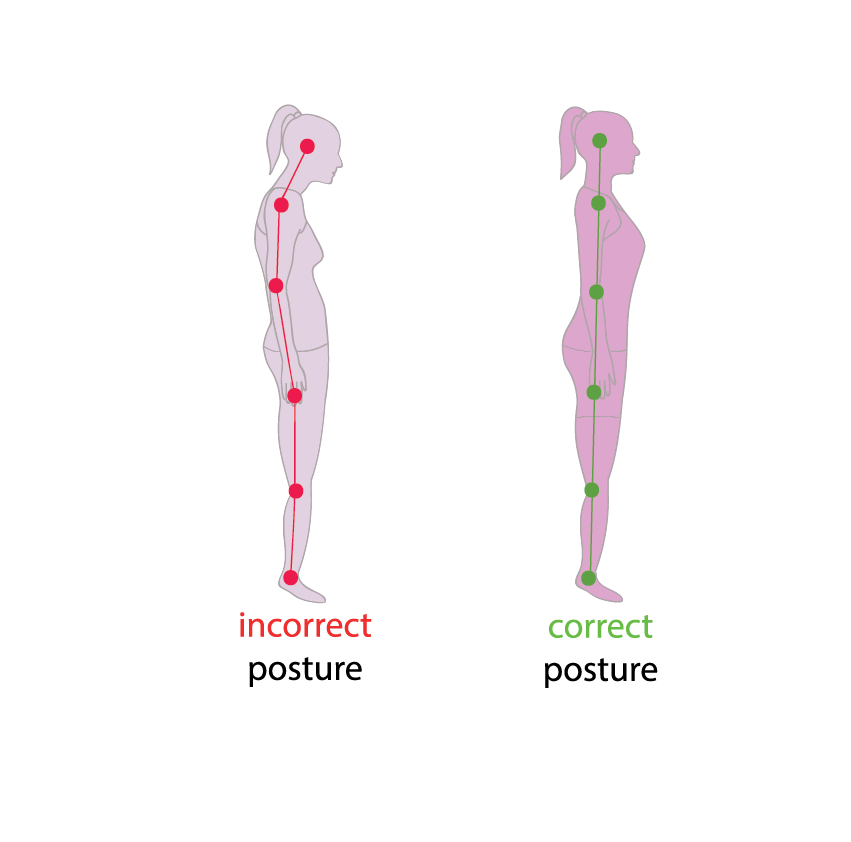Posture, Pelvic Floor Function, and Incontinence – It could be connected!
Hello, I’m Phillipa Butler, a Chartered Physiotherapist and Certified Pilates and Yoga Teacher.
I believe that a regular programme of appropriate exercise is the key to a fitter and healthier future. The pelvic floor is a group of muscles that, when trained, can help to ease the symptoms of bladder weakness. The good news is that it’s never too late to take action and tackle health problems!
What is Posture and what does it have to do with the Pelvic Floor?
Our bodies are complex, with each of our body systems interconnected and dependent on each other. However, it is not always obvious how these connections can influence distant parts of the body and the pelvic floor is a prime example of this phenomenon.
You may be aware that posture is important for the health of your spine, but did you know that how we hold our bodies can have an impact on the pelvic floor?
Posture is defined as the position in which someone holds their body, for example when standing or sitting. Our posture changes and varies as we move through our day performing our different tasks and roles. However, some general principles apply, regardless of what we are doing, that will differentiate a poor posture from an ideal posture.
A poor posture can increase the stresses and strains on joints, muscles, and even your pelvic floor. Making adjustments that improve your posture could help to improve the functioning of the pelvic floor and support the management of incontinence and pelvic floor dysfunction.
We need to explore all possibilities when seeking to address health issues that impact our quality of life. Standing and sitting up straighter could help your pelvic floor, your back, neck, and shoulder joints. Why not give it a try and discover the benefits for yourself?
Is there really such a thing as Bad Posture?
As you can imagine, the answer to this is not simple. However, there are ways that we will move and use our bodies that are less efficient mechanically and can put undue stress and strain on joints and muscles.
Our modern lives have changed how we use our bodies every day. Much of the physicality that was once an integral part of our lives is now reserved for our hobbies or pastimes, and so it is much more optional.
We are also up against our primitive programming that leads us to conserve as much energy as possible just in case we might need to run for our lives. This is much less likely nowadays but if we put this tendency together with our sedentary lifestyles, we have a recipe that can create poor postural habits that we will barely notice. That is until something goes wrong!
So, what does good posture look like and how could that help our pelvic floor?

Check your Posture
Some general principles will differentiate an ideal posture from a poor posture. When we examine the ideal working position of the body, we could imagine standing alongside a line passing vertically from the floor to the ceiling. Ideally, this line should pass adjacent to the following points:
- The opening of the ear canal.
- The bony point of the shoulder (Acromioclavicular joint).
- The bone on the outside of the top of the thigh (Greater trochanter).
- A point just in front of the bony prominence on the outside of the ankle (Lateral malleolus).
In between the shoulder and the hips, you can see the natural curves of the spine, concave in the neck (cervical spine), convex through the upper back (thoracic spine), and concave in the lower back (lumbar spine). These curves should be even and sweeping, not exaggerated or flattened.
As part of a postural assessment, we would also examine the position of the pelvis and the knee joints.
Do you want a 20% discount on your first order?
Receive incontinence tips, expert advice, and promotions by email.
Posture, the Pelvis, and the Pelvic Floor
The pelvis is an important element of posture for a variety of reasons. The centre of gravity lies within the pelvis and the position of the pelvis influences how the spine, ribcage, shoulders, and head will all stack up above it.
It has been suggested that the angle of the pelvis is one of the postural characteristics that can influence the performance of the pelvic floor. Deviations from the normal range of pelvic tilt can influence the symmetry of pelvic floor muscles, which in turn can have an impact on their efficiency and effectiveness. (Oleksy et al. 2019)
How do I know if my Pelvis is tilted?
When we examine posture, the pelvis could be neutral, which is the ideal, tilted forwards (anterior tilt) or backwards (posterior tilt) when we stand at rest. The most common fault is an exaggerated anterior pelvic tilt (Figure 2). This forward tilt reduces the body’s ability to resist forces efficiently and as mentioned could contribute to pelvic floor dysfunction.
We can get an idea of whether the pelvis is tilted or not by observing the direction that the bony prominences on the front of the pelvis (the anterior superior iliac spines or ASIS) are pointing.
If you imagine two headlights shining out of these pointy hip bones, in an ideal world these ‘headlights’ should be ‘shining’ more or less straight ahead of you horizontally (A more technical method to measure this angle is described by Suits et al 2021).
Figures 1 and 2 show differences between an ideal posture and a poor postural presentation.


What is the ideal position of the pelvis?
The ideal alignment of the pelvis is what we call the neutral position. When the pelvis is neutral it brings the lumbar spine into neutral, this allows the spine to stack up above it in the most ideal ‘S’ shape; also referred to as the Natural Curves of the spine.
This ‘S’ shape arrangement of the bones allows the spine to distribute the load most effectively between all the appropriate load-bearing structures, the bones, discs, ligaments, and muscles.
This ideal body position also aligns the pelvic floor in an optimum position for function (Fig 1 above).
What can I do to improve my posture?
The first step is to develop our ability to ‘tune in’ and increase our awareness of HOW we HOLD our bodies. Then to practice this as we go about our daily lives; sitting at a desk, hanging washing, vacuuming, driving to work, mowing the lawn, carrying a baby, or hitting a golf ball!
What is my ideal solution?

Find the Neutral Pelvis
Posture and alignment are key elements of pilates practice, and we can improve the alignment of our bodies by becoming familiar with our own bony landmarks of the pelvis and learning how to adjust and position the pelvis closer to that ideal neutral alignment.
Now join Phillipa to learn how to find the neutral position of the pelvis and improve your posture as you sit and stand.
Make the neutral pelvis a habit for life
Making a lasting change to improve posture and alignment of the pelvis and lumbar spine can help to reduce back pain, improve respiratory function, and could reduce the symptoms of urinary incontinence.
To Sum Up
I hope you are feeling more confident about some steps you can take to improve your pelvic health. It is important to act sooner rather than later to improve your symptoms and prevent a worsening of your condition. Always seek out professional help if your symptoms are affecting your quality of life and/or not responding to simple self-help measures.
Sources
Oleksy Ł, Mika A, Kielnar R, Grzegorczyk J, Marchewka A, Stolarczyk A. The influence of pelvis reposition exercises on pelvic floor muscles asymmetry: A randomised prospective study. Medicine (Baltimore). 2019 Jan;98(2):e13988. doi: 10.1097/MD.0000000000013988. PMID: 30633181; PMCID: PMC6336649.
Suits WH. Clinical Measures of Pelvic Tilt in Physical Therapy. Int J Sports Phys Ther. 2021 Oct 1;16(5):1366-1375. doi: 10.26603/001c.27978. PMID: 34631258; PMCID: PMC8486407.
